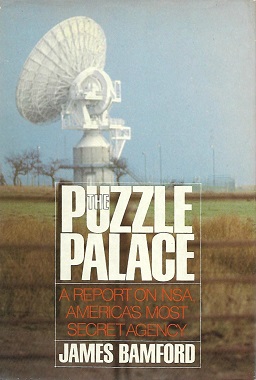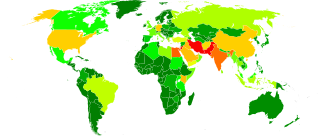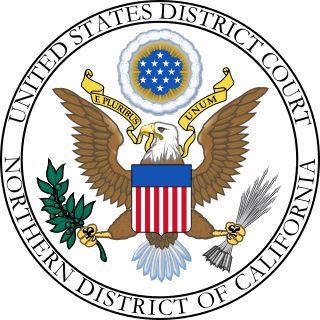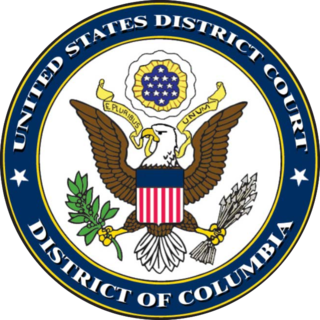Related Research Articles

The United States Foreign Intelligence Surveillance Court (FISC), also called the FISA Court, is a U.S. federal court established under the Foreign Intelligence Surveillance Act of 1978 (FISA) to oversee requests for surveillance warrants against foreign spies inside the United States by federal law enforcement and intelligence agencies.

The National Security Agency (NSA) is a national-level intelligence agency of the United States Department of Defense, under the authority of the Director of National Intelligence (DNI). The NSA is responsible for global monitoring, collection, and processing of information and data for foreign and domestic intelligence and counterintelligence purposes, specializing in a discipline known as signals intelligence (SIGINT). The NSA is also tasked with the protection of U.S. communications networks and information systems. The NSA relies on a variety of measures to accomplish its mission, the majority of which are clandestine. The existence of the NSA was not revealed until 1975. The NSA has roughly 32,000 employees.

The Puzzle Palace is a book written by James Bamford and published in 1982. It is the first major, popular work devoted entirely to the history and workings of the National Security Agency (NSA), a United States intelligence organization. The title refers to a nickname for the NSA, which is headquartered in Fort Meade, Maryland. In addition to describing the role of the NSA and explaining how it was organized, the book exposed details of a massive eavesdropping operation called Operation Shamrock. According to security expert Bruce Schneier, the book was popular within the NSA itself, as "the agency's secrecy prevents its employees from knowing much about their own history".
The state secrets privilege is an evidentiary rule created by United States legal precedent. Application of the privilege results in exclusion of evidence from a legal case based solely on affidavits submitted by the government stating that court proceedings might disclose sensitive information which might endanger national security. United States v. Reynolds, which involved alleged military secrets, was the first case that saw formal recognition of the privilege.
United States v. Reynolds, 345 U.S. 1 (1953), is a landmark legal case decided in 1953, which saw the formal recognition of the state secrets privilege, a judicially recognized extension of presidential power. The US Supreme Court confirmed that "the privilege against revealing military secrets ... is well established in the law of evidence".

Project MINARET was a domestic espionage project operated by the National Security Agency (NSA), which, after intercepting electronic communications that contained the names of predesignated US citizens, passed them to other government law enforcement and intelligence organizations. Intercepted messages were disseminated to the FBI, CIA, Secret Service, Bureau of Narcotics and Dangerous Drugs (BNDD), and the Department of Defense. The project was a sister project to Project SHAMROCK.
Project SHAMROCK was the sister project to Project MINARET, an espionage exercise started in August 1945. Project MINARET involved the accumulation of all telegraphic data that entered or exited the United States. The Armed Forces Security Agency (AFSA) and its successor, the National Security Agency (NSA), were given direct access to daily microfilm copies of all incoming, outgoing, and transiting telegrams via the Western Union and its associates RCA and ITT. NSA did the operational interception, and, if there was information that would be of interest to other intelligence agencies, the material was passed to them. Intercepted messages were disseminated to the FBI, CIA, Secret Service, Bureau of Narcotics and Dangerous Drugs (BNDD), and the Department of Defense. No court authorized the operation and there were no warrants.

NSA warrantless surveillance — also commonly referred to as "warrantless-wiretapping" or "-wiretaps" — refers to the surveillance of persons within the United States, including U.S. citizens, during the collection of notionally foreign intelligence by the National Security Agency (NSA) as part of the Terrorist Surveillance Program. In late 2001, the NSA was authorized to monitor, without obtaining a FISA warrant, phone calls, Internet activities, text messages and other forms of communication involving any party believed by the NSA to be outside the U.S., even if the other end of the communication lays within the U.S.

American Civil Liberties Union v. National Security Agency, 493 F.3d 644, is a case decided July 6, 2007, in which the United States Court of Appeals for the Sixth Circuit held that the plaintiffs in the case did not have standing to bring the suit against the National Security Agency (NSA), because they could not present evidence that they were the targets of the so-called "Terrorist Surveillance Program" (TSP).

Hepting v. AT&T, 439 F.Supp.2d 974, was a class action lawsuit argued before the United States District Court for the Northern District of California, filed by Electronic Frontier Foundation (EFF) on behalf of customers of the telecommunications company AT&T. The plaintiffs alleged that AT&T permitted and assisted the National Security Agency (NSA) in unlawfully monitoring the personal communications of American citizens, including AT&T customers, whose communications were routed through AT&T's network.

MAINWAY is a database maintained by the United States' National Security Agency (NSA) containing metadata for hundreds of billions of telephone calls made through the largest telephone carriers in the United States, including AT&T, Verizon, and T-Mobile.
Warrantless searches are searches and seizures conducted without court-issued search warrants.

EPIC v. Department of Justice is a 2014 case in the United States District Court for the District of Columbia between the Electronic Privacy Information Center (EPIC) and the U.S. Department of Justice (DOJ) where EPIC seeks court action to enforce their Freedom of Information Act request for documents that the Department of Justice has withheld pertaining to George W. Bush's authorization of NSA warrantless surveillance.

Al-Haramain v. Obama, 690 F.3d 1089 was a case before the U.S. District Court for the Northern District of California filed 28 February 2006 by the al-Haramain Foundation and its two attorneys concerning the NSA warrantless surveillance controversy. The case withstood retroactive changes brought by the Congressional response to the NSA warrantless surveillance program.

Jewel v. National Security Agency, 673 F.3d 902, was a class action lawsuit argued before the District Court for the Northern District of California and the Court of Appeals for the Ninth Circuit, filed by Electronic Frontier Foundation (EFF) on behalf of American citizens who believed that they had been surveilled by the National Security Agency (NSA) without a warrant. The EFF alleged that the NSA's surveillance program was an "illegal and unconstitutional program of dragnet communications surveillance" and claimed violations of the Fourth Amendment.
Clapper v. Amnesty International USA, 568 U.S. 398 (2013), was a United States Supreme Court case in which the Court held that Amnesty International USA and others lacked standing to challenge 50 U.S.C. § 1881a of the Foreign Intelligence Surveillance Act as amended by the Foreign Intelligence Surveillance Act of 1978 Amendments Act of 2008.

The practice of mass surveillance in the United States dates back to wartime monitoring and censorship of international communications from, to, or which passed through the United States. After the First and Second World Wars, mass surveillance continued throughout the Cold War period, via programs such as the Black Chamber and Project SHAMROCK. The formation and growth of federal law-enforcement and intelligence agencies such as the FBI, CIA, and NSA institutionalized surveillance used to also silence political dissent, as evidenced by COINTELPRO projects which targeted various organizations and individuals. During the Civil Rights Movement era, many individuals put under surveillance orders were first labelled as integrationists, then deemed subversive, and sometimes suspected to be supportive of the communist model of the United States' rival at the time, the Soviet Union. Other targeted individuals and groups included Native American activists, African American and Chicano liberation movement activists, and anti-war protesters.

Klayman v. Obama, 957 F.Supp.2d 1, was a decision by the United States District Court for District of Columbia finding that the National Security Agency's (NSA) bulk phone metadata collection program was unconstitutional under the Fourth Amendment. The ruling was later overturned on jurisdictional grounds, leaving the constitutional implications of NSA surveillance unaddressed.

Litigation over global surveillance has occurred in multiple jurisdictions since the global surveillance disclosures of 2013.

Wikimedia Foundation, et al. v. National Security Agency, et al. is a lawsuit filed by the American Civil Liberties Union (ACLU) on behalf of the Wikimedia Foundation and several other organizations against the National Security Agency (NSA), the United States Department of Justice (DOJ), and other named individuals, alleging mass surveillance of Wikipedia users carried out by the NSA. The suit claims the surveillance system, which NSA calls "Upstream", breaches the First Amendment to the United States Constitution, which protects freedom of speech, and the Fourth Amendment to the United States Constitution, which prohibits unreasonable searches and seizures.
References
- ↑ Politics Recovered: Realist Thought in Theory and Practice. Columbia University Press. 2018. ISBN 9780231547550.
- ↑ State Secrets Privilege and Other Limits on Litigation Involving Classified Information. Congressional Research Service. March 2010. ISBN 9781437919622.
- ↑ See Intelligence Activities: Hearings Before the Select Comm. to Study Governmental Operations with Respect to Intelligence Activities of the U.S. Senate, 94th Cong., 1st Sess. Vol. V at 9 (1975) (Hearings), cited in Halkin v. Helms
- ↑ State Secret Protection Act of 2009: Hearing Before the Subcommittee on the Constitution, Civil Rights, and Civil Liberties of the Committee on the Judiciary, House of Representatives, One Hundred Eleventh Congress, First Session, on H.R. 984, June 4, 2009, Volume 4. 2009. ISBN 9780160838507.
- ↑ State Secret Protection Act of 2009: Hearing Before the Subcommittee on the Constitution, Civil Rights, and Civil Liberties of the Committee on the Judiciary, House of Representatives, One Hundred Eleventh Congress, First Session, on H.R. 984, June 4, 2009, Volume 4. 2009. ISBN 9780160838507.
- ↑ Who Needs to Know? - The State of Public Access to Federal Government Information. Bernan Press. 13 October 2008. ISBN 9781598883084.
- ↑ Secrets and Leaks: The Dilemma of State Secrecy. Princeton University Press. 10 May 2016. ISBN 9781400880850.